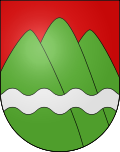Buttes
| Buttes | ||
|---|---|---|
| State : |
|
|
| Canton : |
|
|
| District : | No district division | |
| Municipality : | Val-de-Travers | |
| Postal code : | 2115 | |
| former BFS no. : | 6503 | |
| Coordinates : | 532 488 / 193562 | |
| Height : | 770 m above sea level M. | |
| Area : | 18.20 km² | |
| Residents: | 601 (December 31, 2007) | |
| Population density : | 33 inhabitants per km² | |
| Website: | buttes.ne.ch | |
| map | ||
|
|
||
Until December 31, 2008, Buttes was a municipality in the Val-de-Travers district of the Swiss canton of Neuchâtel .
Since January 1, 2009 Buttes belongs together with Boveresse , Couvet , Fleurier , Les Bayards , Môtiers , Noiraigue , Saint-Sulpice and Travers to the newly formed municipality of Val-de-Travers .
geography
Buttes is 770 m above sea level. M. , 31 km west-southwest of the canton capital Neuchâtel (linear distance). The clustered village extends in the valley of the Buttes stream , which geographically belongs to the valley of the Val de Travers , in the southwestern Neuchâtel Jura .
The area of the 18.2 km² former municipal area includes the Vallon du Buttes valley , which is drained from the Buttes river to the Areuse . This valley has a 700 m wide flat valley floor in the lower part, in the upper part it is cut deep into the heights of the Jura. To the south, the municipality extended over the densely wooded slope to the anticline of the Chasseron . The southern border ran over the ridge of Roches Blanches (at 1,470 m above sea level, the highest point of Buttes), Crêt de la Neige ( 1,457 m above sea level ; not to be confused with the highest mountain of the Jura of the same name) and Crêt des Lisières . To the north, the communal soil extended to the wide anticline of the Montagne de Buttes ( 1245 m above sea level ). Here there are extensive Jura high pastures with the typical mighty spruce trees , which either stand individually or in groups. In 1997, 4% of the municipal area was in settlements, 60% in forests and woodlands, 35% in agriculture and a little less than 1% was unproductive land.
The hamlet of Mont de Buttes ( 1056 m above sea level ) on a protrusion on the southern slope of the Montagne de Buttes as well as numerous farm settlements and individual farms on the Montagne de Buttes belonged to Buttes. Neighboring municipalities of Buttes were La Côte-aux-Fées , Les Verrières , Les Bayards , Saint-Sulpice and Fleurier in the canton of Neuchâtel and Fontaines-sur-Grandson and Fiez in the canton of Vaud .
population
With 610 inhabitants (at the end of 2006) Buttes was one of the smaller communities in the canton of Neuchâtel. 90.7% of the residents are French-speaking, 3.3% Portuguese-speaking and 3.0% German-speaking (as of 2000). The population of Buttes increased continuously until 1870 (1436 inhabitants). From 1900 to 1990 (594 inhabitants) it decreased by more than half, and since then a slight increase has been recorded.
economy
For a long time, Buttes was mainly an agricultural village. In the 18th century, the asphalt discovered there by the German Jost was partially dismantled (later at La Presta ). A brick factory was operated until 1862, after which the watch industry gradually gained acceptance . The last watch manufacture was closed in 1991. Today there are jobs in mechanical workshops and in local small businesses. Agriculture with livestock and dairy farming and forestry are also still important. Many workers are also commuters and work in the larger towns of the Val de Travers or in Neuchâtel .
traffic
The former community is well developed in terms of traffic. It is located on the main road from Fleurier to Sainte-Croix . On September 11, 1886, the RVT railway line from Fleurier to Buttes was inaugurated. From the Buttes train station, there is a postbus course to La Côte-aux-Fées and, in some cases, to Sainte-Croix . A cable car leads to the terrace of Petite Robella, where ski lifts operate in winter .
history
The first written mention of the place took place around 1300 under the name Boutes . The place was a horse changing station on the Vy Saulnier, a former salt road from France through the Jura to Neuchâtel. Buttes initially belonged to the Saint-Pierre priory in Môtiers , then from the 14th century until 1848 it was under the control of the Kastlanei Val-de-Travers. During this time, the county of Neuchâtel had sovereignty over the area. From 1648 Neuchâtel was a principality and from 1707 it was linked to the Kingdom of Prussia through personal union. In 1806 the area was ceded to Napoleon I and came to the Swiss Confederation in the course of the Congress of Vienna in 1815 , whereby the kings of Prussia until 1848 (formally until the Neuchâtel trade in 1857) also remained princes of Neuchâtel.
Attractions
The reformed village church of Buttes was built in 1705, the steeple dates from 1854. It stands on the site of the former Saint-Maurice chapel.
literature
- Eric-André Klauser: Buttes. In: Historical Lexicon of Switzerland .
- Jean Courvoisier: The art monuments of the canton of Neuchâtel. Volume III: Les districts du Valde-Travers, du Val-de-Ruz, du Locle et de La Chaux-de-Fonds. (= Art Monuments of Switzerland. Volume 56). Edited by the Society for Swiss Art History GSK. Bern 1968.




